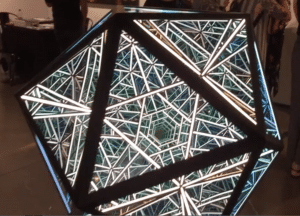
The author of this article, Nathaniel Wulff, is a guest contributor to What Is Metamodern?
***
The Priest: Why would you believe in something awful when you can believe in something wonderful!?
Fleabag: Don’t make me an optimist; you will ruin my life.
Fleabag, a two season Emmy Award-winning series for Amazon and BBC3, created by, written by, and starring Phoebe Waller-Bridge, follows the often destructive attempts to cope with life by an unnamed character referred to in the script only as Fleabag. And our protagonist does have a lot to cope with: Her grief over her departed mother, the suicide of her best friend, her failure as business owner of a café, the quality of her sexual relationships, and her limited ability to connect with those close to her. However, Fleabag’s suffering is not immediately evident due to her penchant for steeping her bleak experiences in irony and cheeky self-awareness. The show initially relishes postmodern approaches to humor, storytelling, subjectivity, and experience only to reveal their failures and the need for alternatives.
Fleabag, in the mold of Transparent, Orange Is the New Black, Louie, and Atlanta, is an untraditional comedy. These recent, arguably metamodern, dramedies all reflect a refusal to tidy up the complicated social and personal issues brought to the fore, and to in fact utilize the uncomfortable and the complex in order to showcase interiority. Media theorists Gry C. Rustad and Kai Hanna Schwind describe the tone of Louie, as “fueled by its protagonist’s feelings of oscillation between personal doubt and self-loathing on the one hand and a desperate search for love and human kindness on the other” (“The Joke…”, 141). Fleabag pushes this exploration more deeply.
In an arc extending over the two seasons that evokes narratives of addiction recovery, Waller-Bridge seems to suggest that personal doubt, self-loathing, and yearning might be innate life experiences, but they should be processed rather than brooded upon or identified with. At least they should act as a kind of invitation rather than a stopping point.
In contrast, a squarely postmodern show like Seinfeld reflects what Rustad and Schwind argue is “a constant desire to foreground the jokes and punch lines, and by no means to engage in an authentic portrayal of characters and behavior” (“The Joke…”, 139). Many postmodern viewers could relate to the meaninglessness and fragmentation of such sitcoms, which rebelled against Brady Bunch-style resolutions in which everything might be resolved by the end of the episode, in favor of a Seinfeldian sense of detachment and irresolution.
Fleabag’s existential ingenuity becomes evident in the second season as the show takes on the topics of faith and receptibility. Fleabag enters into her personal exploration not uncritical of religion. “I’m normal,” Fleabag defiantly asserts, “I don’t believe in God” (S2E2). The writer has described in interviews feeling reticent to depict a conflicted stance on religion, and that she depended on the somewhat unhinged and arousing performance of Andrew Scott playing a character named only “The Priest.” The character, and the show itself, are self-aware about postmodern criticisms of organized religion, like pedophilic stereotypes of priests. (–The Priest confides that he severed a relationship with his brother because of his brother’s pedophilia–S2E1.) However, he is not an entirely wholesome character either, spending much of the time swearing, pulling gin from hidden corners of his office in the church, and battling his own strange anxieties, personified into the form of a fox.
In many ways, The Priest serves as a striking example of a metamodern character type: aware of the ironies of his life and position but optimistic nevertheless. Fleabag, who has demonstrated her cynicism for the whole first season, is both intrigued and made wary by his attitude. When she enters into his office, filled with children’s toys for an upcoming fundraiser (perhaps illustrating a perception that belief in a higher power is childish), the tension persists. Her confession to him (in the literal, Catholic sense), shows that through her high level of ambivalence, she badly wants to believe comfort might be available through religion: “Even though I don’t believe your bullshit, and I know that scientifically nothing I do makes any difference in the end anyway, I’m still scared! Why am I still scared?!” (S2E4) Her reaction of vulnerability breaks from the postmodern identification with meaninglessness described earlier, launching the show into more metamodern territory.
By the end of season 2, Fleabag has not converted. But one can interpret that she may be finding a means of incorporating faith into her life in a manner that does not force her to do away with her individuality nor even her agnosticism. At a dinner in the first episode of season 2, Fleabag’s uptight sister, Claire, stumblingly paraphrases a Finnish maxim that actually fits the character flaws of both the sisters: “You have to open yourself up to the love people are trying to give you.” This receptivity and trust in others’ love, even as words, emotions, and obligations obfuscate, is the faith to which Fleabag devotes herself by the end of the season.
Faith in others requires vulnerability and forgiveness, which Fleabag covers effectively in both seasons. Especially nuanced are the ways Waller-Bridge explores the concept of the self. She begins with a postmodern sense of self that feels both absent and wounded. In the late 20th century, theorists who proclaimed the “death of the subject” suggested that the self was dependent and constructed by the interplay between others. This alienation is evoked in the way Fleabag breaks the fourth wall, speaking directly to her audience across the screen. Through this quintessentially postmodern technique, the show reminds the viewer that it is indeed a show, and that Fleabag’s reality is constructed.
The breaking of the fourth wall is not an uncommon device, and indeed, in Fleabag’s first season, the protagonist’s frequent asides to the viewer can come across as nothing more than playful, cheeky disruptions of narrative convention. However, by the end of Season One it becomes apparent that this audience-directed commentary reveals something deeper about our heroine’s psychology. And then Season Two provides a twist that may well be unique to this show – the breaking of the breaking of the fourth wall. Intimacy between Fleabag and The Priest grows and he begins to notice and call out these asides. Evidently, within the reality of the show, he is not actually hearing the specific words that she says, but he notices something change in her and asks her what is going on – “Where did you go?” Fleabag herself never provides a conclusive answer, but her squirming evasion suggests that what The Priest is observing in her is a sort of dissociation emanating from her need to understand herself in relation to an audience. In other words, in a metamodern inversion of the fourth-wall break, we are pointed inward towards the main character’s felt experience.
Throughout both seasons, pretty much all the characters show a lack of ability to fully express themselves, whether it’s a father’s bumbling attempts to connect with his daughters, the priest’s conflicted vow of celibacy, Fleabag and Clair’s inability to manage themselves appropriately on a silent retreat, or any number of ordinary insecurities. Even humor, as Fleabag’s therapist points out, can conceal one’s sincerity. “Is that a joke?” asks the therapist during a session gifted to Fleabag by her father for her birthday. “It would be good not to make jokes in here just in case anything gets lost in humorous translation (S2E2).”
The first season also points to the way obtaining access to even our own subjectivity is limited, making it even more challenging to convey our interiority to others. Waller-Bridge eventually insists, however, that instead of admitting defeat, we must faithfully submit to our will and let ourselves be known. That is, submit to our desires and become vulnerable to our sense of want so that we can more clearly see and follow the paths that will lead us there.
Nicoline Timmer’s 2017 metamodern analysis of David Foster Wallace’s work elaborates on this in a way that I think aptly applies in Fleabag. “Feelings, however vague and diffuse, can … function as orienting markers that situate a person in relation to other persons. Making sense is, from this perspective, no longer perceived to be a purely cognitive affair and the sole responsibility of a supposed autonomous subject; neither is the self in this view a subject passively imprinted by existing structures of meaning.” This renders Fleabag as an agent in her life increasing her receptivity to others.
Clichéd as it may be, Fleabag learns to love herself. And since she better knows her self, she can start recognizing, with a leap of faith, the other selves out there fighting through this life, too. Then, she can engage with them even through disappointing situations. She gets to feel the sadness without the dread. This trust allows her at the end of the series, even after heartbreak, to let go of her controlling self-awareness as she gently gestures us away and the song begins to play, reflecting her hard-won belief. “It feels so nice to know I’m gonna be alright.”
Print sources
Rustad, Gry C. and Schwind, Kai Hanno. “The Joke That Wasn’t Funny Anymore: Reflections on the Metamodern Sitcom,” in Metamodernism: Historicity, Affect and Depth After Postmodernism, Robin van den Akker, Alison Gibbons and Timotheus Vermeulen, eds. NY: Rowman and Littlefield, 2017.
Timmer, Nicoline. “Radical Defenselessness,” Metamodernism: Historicity, Affect and Depth After Postmodernism, 2017.
*****
You may also enjoy this earlier post:


